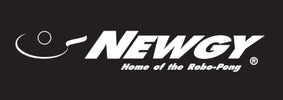Footwork Drills
Yeushan Goan
Milwaukee, WI
The Newgy Robot is very useful for footwork practice. You are forced to keep moving because the robot rarely misses. Here are some footwork drills you can do with your Newgy Robot:
One-Step Footwork
1. Set Oscillator Control Levers to 2,5 (narrow sweep range).
2. Adjust oscillator speed so ball are place at each end of the sweep range.
3. Hit ball coming to your forehand court with forehand strokes, hit balls coming to your backhand court with backhand strokes.
Two-Step Footwork
1. Set Oscillator Control Levers to 1,6 (no oscillation).
2. Alternate your forehands and backhands to hit balls back.
Three-Step Footwork
1. Set Oscillator Control Levers to 2,5 (narrow sweep range).
2. Adjust oscillator speed so balls are placed at each end of the sweep range.
3. Hit balls coming to your forehand court with backhand strokes and balls coming to your backhand court with forehand strokes.
Stepping In/Out Footwork Drills
Two-Step Footwork
1. Set Oscillator Control Levers to 1,6 (no oscillation).
2. Adjust head angle and ball speed so balls bounce twice on your side of the table.
3. Step in to forehand hit a ball after it bounces once, then step out to forehand hit the next ball after it bounces twice, step in to backhand hit the next ball after it bounces once, and finally step out to backhand hit the fourth ball after it bounces twice. You should be moving in an "8 on its side" (_) route.
Three-Step Footwork
1. Set Oscillator Control Levers to 2,5 (narrow sweep range).
2. Adjust head angle and ball speed so balls bounce twice on your side of the table.
3. Hit balls in the same manner as described in previous two-step footwork drill, except you now need to take 3 steps to make it to the balls.
Notes:
a. If you find the 2,5 sweep range too wide for you, change it to 1,5 or 2,6.
b. If you find the 2,5 sweep range too narrow for you, change it to 2,4, 3,5 or even 3,4.
c. If you're right-handed you should step in with your right foot closer to the table, or you won't be able to bring your playing hand close to the ball.
d. If you're left-handed, you should step in with your left foot closer to the table.





